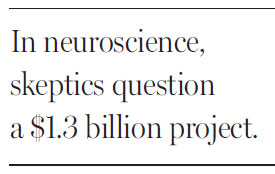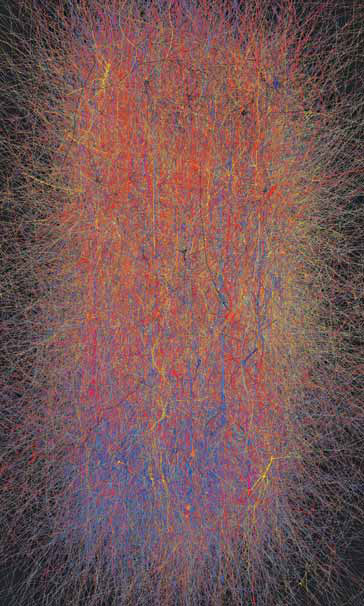An effort to build a virtual brain
Updated: 2013-03-31 08:20
By Tim Requarth(The New York Times)
|
|||||||||
|
The Blue Brain computer, which was switched on for the first time in 2006, has 10,000 virtual neurons replicating brain activity. Blue Brain Project / Ecole Polytechnique Federale De Lausanne |

For months, Henry Markram and his team had been feeding data into a supercomputer at the Swiss Federal Institute of Technology in Lausanne.
The computer housed thousands of microchips, each programmed to act like a brain cell. Cables carried signals from microchip to microchip, just as cells do in a real brain.
In 2006, Dr. Markram flipped the switch. Blue Brain, a tangled web of nearly 10,000 virtual neurons, crackled to life. As millions of signals raced along the cables, electrical activity resembling real brain waves emerged.
"That was an incredible moment," he said. "It didn't match perfectly, but it was pretty good. As a biologist, I was amazed."
Deciding then that simulating the entire brain on a supercomputer would be possible within his lifetime, Dr. Markram, now 50, set out to prove it.
That is no small feat. The brain contains nearly 100 billion neurons organized into networks with 100 trillion total connections, all firing split-second spikes of voltage in a mix of complex molecules in constant flux.
In 2009, Dr. Markram conceived of the Human Brain Project, a controversial initiative of more than 150 institutions around the world. In January, the European Union awarded the project a 10-year grant of up to $1.3 billion.
"A meticulous virtual copy of the human brain," Dr. Markram wrote in Scientific American, "would enable basic research on brain cells and circuits or computer-based drug trials."
An equally ambitious "big brain" idea is in the works in the United States: The Obama administration is expected to propose its own project, with up to $3 billion allocated over a decade to develop technologies to track the electrical activity of every neuron in the brain.
But just as many obstacles stand in the way of the American project, a number of scientists have expressed serious reservations about Dr. Markram's project. Some say we don't know enough about the brain to simulate it on a supercomputer. And even if we did, these critics ask, what would be the value of building such a complicated "virtual brain"?
The Human Brain Project grew out of work that began while Dr. Markram, originally from South Africa, was at the Max Planck Institute in Germany. It was there where he made his most famous discovery. He was pondering how the brain learns cause and effect. He set up an experiment to record the electrical activity from two connected neurons in a slice from a rat's brain, and discovered that the neurons required a precise sequence of voltage spikes to change the strength of their connections. He speculated that the mechanism might be at the root of our notion of causality.

That work has now been cited thousands of times.
In his first faculty position, at the Weizmann Institute in Israel, Dr. Markram set up a wildly ambitious rig that could record data not just from 2 neurons in a rat's brain but also from 12.
Soon Dr. Markram would learn that his son, Kai, had autism. "You know how powerless you feel," he said. "You have this child with autism, and you, even as a neuroscientist, really don't know what to do."
He began to question the impact of his work. "I realized that I could write a high-profile research paper every year, but then what?" he said. "I die, and there's going to be a column on my grave with a list of beautiful papers."
Dr. Markram decided he needed to change his approach. After hearing of a new I.B.M. supercomputer, he asked himself, what if each microchip of the supercomputer represented a neuron in the brain? You could run simulations to perform virtual experiments and, unlike in real experiments, watch every single "neuron" in action."If I build in enough biological detail," he reasoned, "it would behave like a real brain."
Dr. Markram moved his lab to the Swiss Federal Institute of Technology, which agreed to buy the $10 million supercomputer. Armed with data from 20,000 experiments, Dr. Markram began to build Blue Brain.
By 2008, he said, his team had created a "digital facsimile" of a piece of tissue in the rat cortex. In 2011, the team had simulated a "virtual slice" of brain tissue with one million neurons.
He proposed the Human Brain Project, which would scale up Blue Brain to simulate the human brain.
But many scientists are highly skeptical of Blue Brain's accomplishments. While the team may have achieved a computer simulation of something, critics say, it was not a brain slice.
Some researchers say it is premature to invest money in a simulation while important principles of brain function remain to be discovered.
Other critics say the project is too open-ended, with no clearly defined criteria for success.
Some say the real issue is how the field of neuroscience should harness its resources.
"Some 10,000 laboratories worldwide are pursuing distinct questions about the brain," Christof Koch, of the Allen Institute for Brain Science in Seattle, wrote in the journal Nature. "Neuroscience is a splintered field."
Dr. Markram agreed. The Human Brain Project, he said, will provide a "unifying principle" for scientists to rally around.
"The biggest success for me," Dr. Markram said, "would be if after 10 years, we have a new model for neuroscience, where everyone works together."
The New York Times
(China Daily 03/31/2013 page11)
